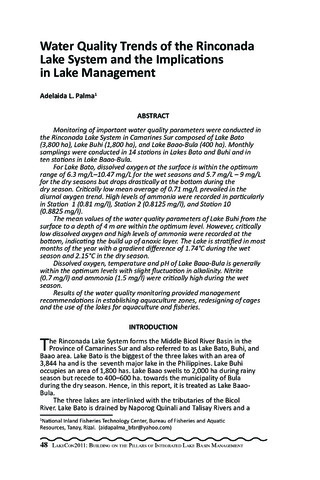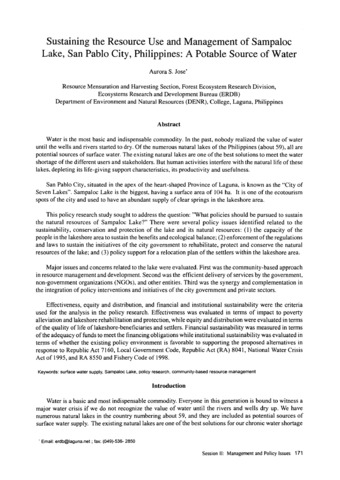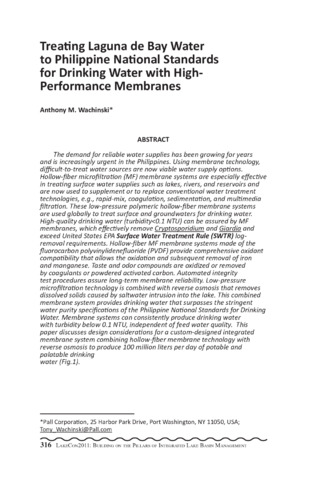Land use and water quality assessment of some lakes in San Pablo City, Laguna, Philippines
| dc.contributor.author | Claveria, Rene Juna R. | |
| dc.contributor.author | Perez, Teresita R. | |
| dc.contributor.author | Unson, Jewel Racquel S. | |
| dc.contributor.author | Roque, Jillian T. | |
| dc.contributor.author | Bayugo, Gillian Mari S. | |
| dc.contributor.author | Aquino, Joselito B. | |
| dc.contributor.author | Rebusura, Marvin | |
| dc.contributor.editor | Aralar, Maria Lourdes C. | |
| dc.contributor.editor | Borja, Adelina S. | |
| dc.contributor.editor | Palma, Adelaida L. | |
| dc.contributor.editor | Mendoza, Marlynn M. | |
| dc.contributor.editor | Ocampo, Pablo C. | |
| dc.contributor.editor | Manalili, Eduardo V. | |
| dc.contributor.editor | Darvin, Loureeda C. | |
| dc.date.accessioned | 2020-06-18T02:47:21Z | |
| dc.date.available | 2020-06-18T02:47:21Z | |
| dc.date.issued | 2013 | |
| dc.identifier.citation | Claveria, R. J. R., Perez, T. R., Unson, J. R. S., Roque, J. T., Bayugo, G. M. S., Aquino, J. B., & Rebusura, M. (2013). Land use and water quality assessment of some lakes in San Pablo City, Laguna, Philippines. In M. L. C. Aralar, A. S. Borja, A. L. Palma, M. M. Mendoza, P. C. Ocampo, E. V. Manalili, & L. C. Darvin (Eds.), LakeCon2011: Building on the pillars of Integrated Lake Basin Management (Second National Congress on Philippine Lakes) (p. 309). Los Baños, Laguna, Philippines: PCAARRD-DOST. | en |
| dc.identifier.issn | 1656-8099 | |
| dc.identifier.uri | http://hdl.handle.net/10862/5864 | |
| dc.description.abstract | Land conversions brought about by increasing population and the apparent increase of agricultural, residential, and commercial activities in San Pablo City have affected the quality of the water resources in the area. Agriculture and built-up areas comprised the majority of land use. Their assessment generated new interpretative maps after integrating remotely sensed data such as Landsat image and aerial photographs to various land use studies and surveys. The degradation of surface water quality was manifested by the physico-chemical analyses of sediments deposited in selected rivers and lakes. Sediments are considered as important source of information regarding water quality and chemical composition of water bodies. Sediments from Palacpaquen Lake and its adjoining rivers were assessed. The sulfate values of samples taken from different sites range from 47.79 ppm to 292.29 ppm, phosphates from 0.79 ppm to 5.53 ppm, nitrates from 146.98 ppm to 370.50 ppm, and organic carbon from 0.98 ppm to 4.56 ppm. The observed variability of nutrient concentrations were attributed mainly to anthropogenic activities around the lake and rivers which include agriculture, domestic and aquaculture. Land use has also affected groundwater resources, being one of the principal sources of drinking water. Untreated spring and well water are vulnerable to industrial, domestic, and agricultural pollution. Spring and well water from selected lakes such as Sampaloc, Mohicap, and Palacpaquen were monitored for total and fecal coliform contamination levels. There were varied levels of contamination. In most cases, the microbiological water quality in the sampled sites did not pass the drinking water standards of the Department of Health and the Department of Environment and Natural Resources. Proper land and water resource planning and management should be implemented to address the water quality degradation in San Pablo City. | en |
| dc.language.iso | en | en |
| dc.publisher | PCAARRD-DOST | en |
| dc.relation.ispartofseries | Summary of Proceedings No. 1/2013; | |
| dc.title | Land use and water quality assessment of some lakes in San Pablo City, Laguna, Philippines | en |
| dc.type | Conference paper | en |
| dc.citation.spage | 309 | en |
| dc.citation.conferenceTitle | LakeCon2011: Building on the pillars of Integrated Lake Basin Management (Second National Congress on Philippine Lakes) | en |
| dc.subject.asfa | land use | en |
| dc.subject.asfa | water quality | en |
| dc.subject.asfa | evaluation | en |
| dc.subject.asfa | water resources | en |
| dc.subject.asfa | environmental degradation | en |
| dc.subject.asfa | physicochemical properties | en |
| dc.subject.asfa | sediment | en |
このアイテムのファイル
| ファイル | サイズ | フォーマット | 閲覧 |
|---|---|---|---|
|
このアイテムに関連するファイルは存在しません。 |
|||
このアイテムは次のコレクションに所属しています
-
LakeCon2011 [30]
2nd National Congress on Philippine Lakes



